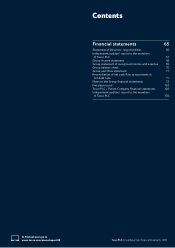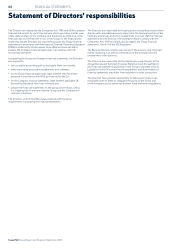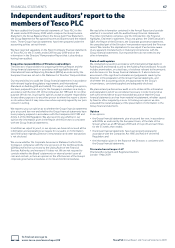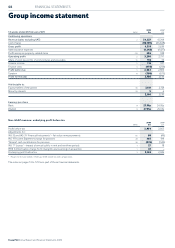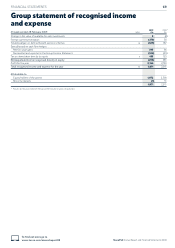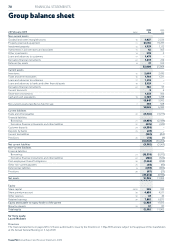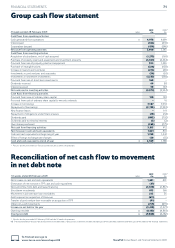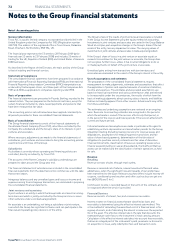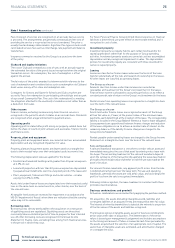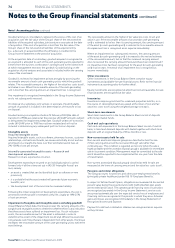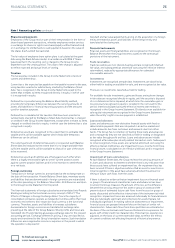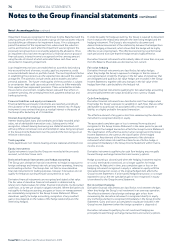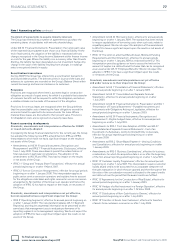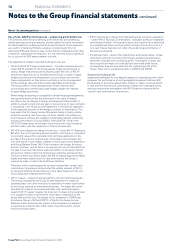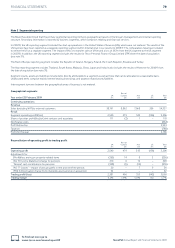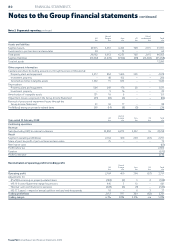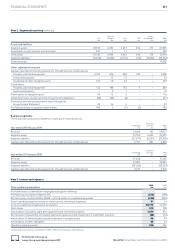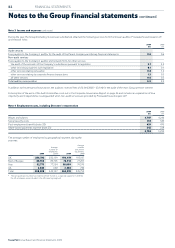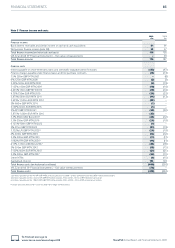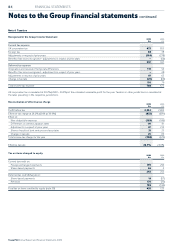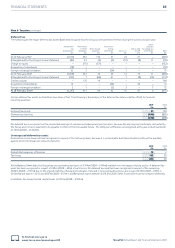Tesco 2009 Annual Report Download - page 77
Download and view the complete annual report
Please find page 77 of the 2009 Tesco annual report below. You can navigate through the pages in the report by either clicking on the pages listed below, or by using the keyword search tool below to find specific information within the annual report.
75
FINANCIAL STATEMENTS
Tesco PLC Annual Report and Financial Statements 2009
To find out more go to
www.tesco.com/annualreport09
Share-based payments
Employees of the Group receive part of their remuneration in the form of
share-based payment transactions, whereby employees render services
in exchange for shares or rights over shares (equity-settled transactions)
or in exchange for entitlements to cash payments based on the value of
the shares (cash-settled transactions).
The fair value of employee share option plans is calculated at the grant
date using the Black-Scholes model. In accordance with IFRS 2 ‘Share-
based payment’, the resulting cost is charged to the Group Income
Statement over the vesting period. The value of the charge is adjusted
to reflect expected and actual levels of vesting.
Taxation
The tax expense included in the Group Income Statement consists of
current and deferred tax.
Current tax is the expected tax payable on the taxable income for the year,
using tax rates enacted or substantively enacted by the Balance Sheet
date. Tax is recognised in the Group Income Statement except to the
extent that it relates to items recognised directly in equity, in which case
it is recognised in equity.
Deferred tax is provided using the Balance Sheet liability method,
providing for temporary differences between the carrying amounts of
assets and liabilities for financial reporting purposes and the amounts
used for taxation purposes.
Deferred tax is calculated at the tax rates that have been enacted or
substantively enacted by the Balance Sheet date. Deferred tax is charged
or credited in the Group Income Statement, except when it relates to items
charged or credited directly to equity, in which case the deferred tax is also
recognised in equity.
Deferred tax assets are recognised to the extent that it is probable that
taxable profits will be available against which deductible temporary
differences can be utilised.
The carrying amount of deferred tax assets is reviewed at each Balance
Sheet date and reduced to the extent that it is no longer probable that
sufficient taxable profits will be available to allow all or part of the asset
to be recovered.
Deferred tax assets and liabilities are offset against each other when
there is a legally enforceable right to set-off current taxation assets
against current taxation liabilities and it is the intention to settle these
on a net basis.
Foreign currencies
Transactions in foreign currencies are translated at the exchange rate on
the date of the transaction. At each Balance Sheet date, monetary assets
and liabilities that are denominated in foreign currencies are retranslated
at the rates prevailing on the Balance Sheet date. All differences are taken
to the Group Income Statement for the period.
The financial statements of foreign subsidiaries are translated into Pounds
Sterling according to the functional currency concept of IAS 21 ‘The
Effects of Changes in Foreign Exchange Rates’. Since the majority of
consolidated companies operate as independent entities within their local
economic environment, their respective local currency is the functional
currency. Therefore, assets and liabilities of overseas subsidiaries
denominated in foreign currencies are translated at exchange rates
prevailing at the date of the Group Balance Sheet; profits and losses are
translated into Pounds Sterling at average exchange rates for the relevant
accounting periods. Exchange differences arising, if any, are classified as
equity and transferred to the Group’s translation reserve. Such translation
differences are recognised as income or expenses in the period in which
the operation is disposed of.
Goodwill and fair value adjustments arising on the acquisition of a foreign
entity are treated as assets and liabilities of the foreign entity and
translated at the closing rate.
Financial instruments
Financial assets and financial liabilities are recognised on the Group’s
Balance Sheet when the Group becomes a party to the contractual
provisions of the instrument.
Trade receivables
Trade receivables are non interest-bearing and are recognised initially at
fair value, and subsequently at amortised cost using the effective interest
rate method, reduced by appropriate allowances for estimated
irrecoverable amounts.
Investments
Investments are recognised at trade date. Investments are classified as
either held for trading or available-for-sale, and are recognised at fair value.
There are no investments classified as held for trading.
For available-for-sale investments, gains and losses arising from changes
in fair value are recognised directly in equity, until the security is disposed
of or is determined to be impaired, at which time the cumulative gain or
loss previously recognised in equity is included in the net result for the
period. Interest calculated using the effective interest rate method is
recognised in the Group Income Statement. Dividends on an available-for-
sale equity instrument are recognised in the Group Income Statement
when the entity’s right to receive payment is established.
Loans and advances
Loans and advances are non-derivative financial assets with fixed or
determinable payments that are not quoted in an active market and
include amounts due from customers and amounts due from other
banks. The Group has no intention of trading these loans and advances
and consequently they are not classified as held for trading or designated
as fair value through profit and loss. Loans and advances are initially
recognised at fair value plus directly related transaction costs. Subsequent
to initial recognition, these assets are carried at amortised cost using the
effective interest method less any impairment losses. Income from these
financial assets is calculated on an effective yield basis and is recognised
in the Group Income Statement.
Impairment of loans and advances
At each Balance Sheet date, the Group reviews the carrying amounts of
its loans and advances to determine whether there is any indication that
those assets have suffered an impairment loss. An impairment loss has
been incurred if there is objective evidence that an event or events since
initial recognition of the asset have adversely affected the amount or
timing of future cash flows from the asset.
If there is objective evidence that an impairment loss on a financial asset
or group of financial assets classified as loans and advances has been
incurred, the Group measures the amount of the loss as the difference
between the carrying amount of the asset or group of assets and the
present value of estimated future cash flows from the asset or group of
assets discounted at the effective interest rate of the instrument at initial
recognition. Impairment losses are assessed individually for financial assets
that are individually significant and collectively for assets that are not
individually significant. In making collective assessments of impairment,
financial assets are grouped into portfolios on the basis of similar risk
characteristics. Future cash flows from these portfolios are estimated on
the basis of the contractual cash flows and historical loss experience for
assets with similar credit risk characteristics. Historical loss experience is
adjusted, on the basis of current observable data, to reflect the effects
of current conditions not affecting the period of historical experience.
Note 1 Accounting policies continued


